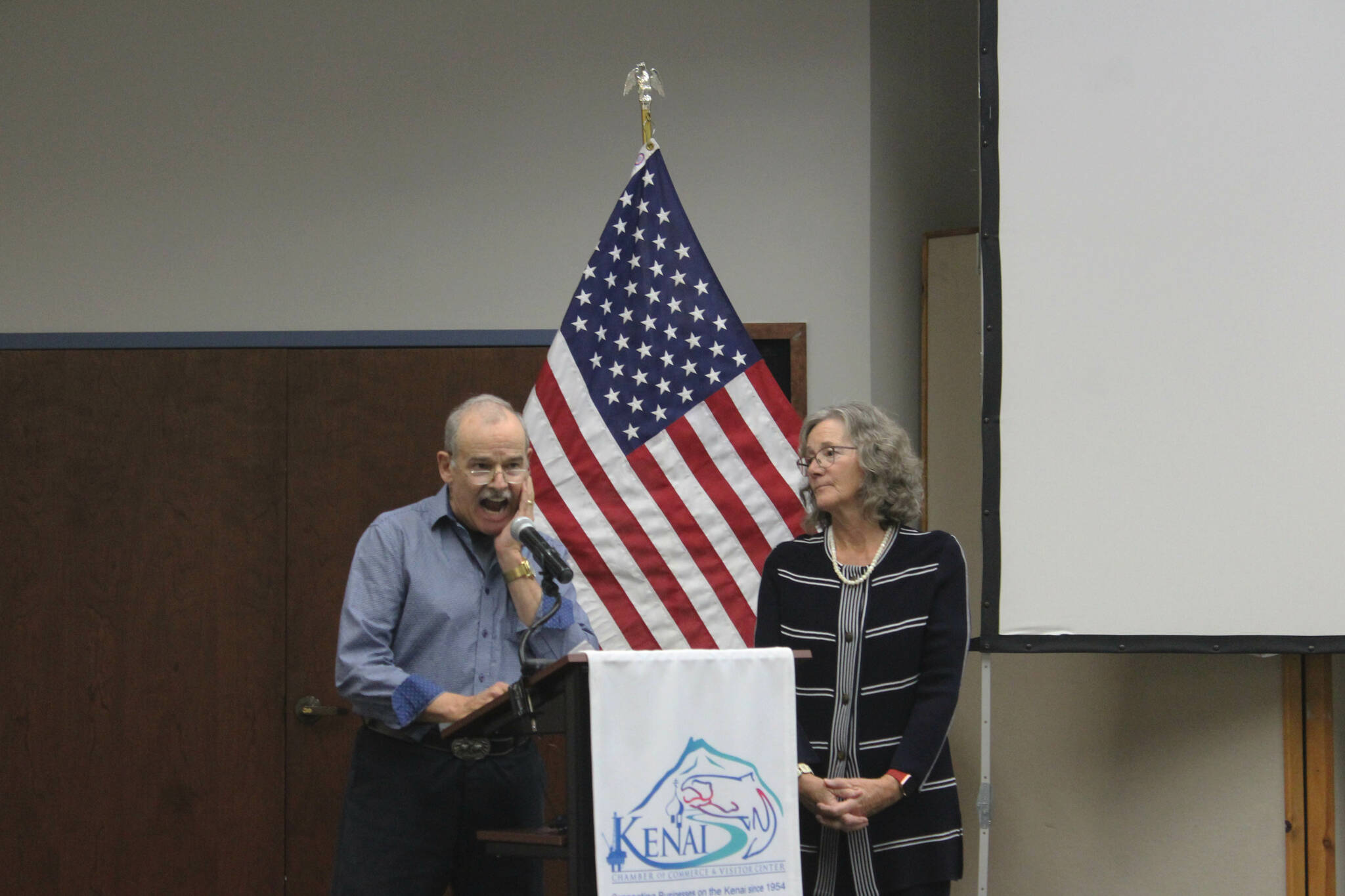KENAI — Advocates on both sides of Alaska’s constitutional convention question faced off at a forum in Kenai on Wednesday.
The forum was hosted by the Kenai and Soldotna chambers of commerce at the Kenai Chamber of Commerce and Visitor Center in Kenai. The forum came about two weeks after a similar forum was held in Anchorage. That forum was hosted by Alaska Public Media in partnership with the Anchorage Daily News and the Alaska Beacon.
Arguing in support of a constitutional convention was Bob Bird, who serves on the steering committee of ConventionYES!, an advocacy group that encourages people to vote “yes” during the Nov. 8 election on a constitutional convention. Arguing in opposition of a convention was Lisa Parker of Defend Our Constitution, an advocacy group that opposes the convention ballot question.
Alaskans will be asked on the Nov. 8 general election ballot: “Shall there be a constitutional convention?” The question is put before Alaska voters every 10 years, as required by the state’s founding document.
Those who oppose the measure say a constitutional convention would open the document to outside influence and potentially threaten Alaskans’ existing freedoms, while those in favor say a convention would provide an opportunity to address some of the state’s biggest concerns, such as Alaska Permanent Fund dividend payments.
If Alaskans vote in favor of calling a constitutional convention, any proposed changes to the document would also need to be approved by voters. Convention supporters say that process is one of the safeguards against unwanted amendments.
Bird and Parker reiterated key tenets of their respective groups’ platforms throughout the forum. Parker focused on the reasons not to have a convention at all — its “unnecessary, expensive and dangerous,” while Bird emphasized statewide issues that having a convention could solve — the Alaska Legislature’s annual PFD problem and what he said was a “rigged” judicial council system.
Parker, who spoke first, explained that some estimates put the total cost of holding a convention at around $17 million. She underscored what the Defend Our Constitution group says is the danger of opening the entire document to political squabbling. Even if delegates go in focused on the PFD, she said, a convention would subject all parts of the document to change by different political ideologies.
“A convention is dangerous,” Parker said. “It would open a Pandora’s box. Everything in our state constitution … could be on the table. There are unknown impacts on fiscal policy, taxes, PFD — it is very much an unknown as to what would happen.”
Bird criticized the amount of money backing the “Defend Our Constitution” group that comes from outside of Alaska and said too many arguments in opposition to a convention are rooted in fear.
“Oh my goodness, what are they afraid of?” Bird said.
He said “liberal Democrats” support maintaining the status quo in Alaska. Bird also directly addressed concerns about abortion access in Alaska, which many convention opponents say could be threatened following the overturning of Roe v. Wade. Abortion access is currently protected in Alaska under the constitution’s Right to Privacy section.
“Roe was egregiously wrong from the start,” Bird said. “Its reasoning was exceptionally weak, the decision has had damaging consequences — turn it over to the people where it belongs.”
“ConventionYES!” literature throughout the room explained that the convection is “three votes of the people”: the initial vote to hold a convention, the subsequent vote to elect delegates and the final vote to ratify proposed changes to the document.
Presentations by both Parker and Bird were followed by a question-and-answer session with audience members. Parker and Bird said they would run to be convention delegates if given the opportunity.
Both sides of the issue, including Parker and Bird, tend to agree that the Alaska Legislature is unlikely to make its own changes to the document.
The Legislature is able to call a convention at any time. Amendments to the constitution can be made by two-thirds vote of the members of the Alaska House of Representatives and in the Alaska Senate, though some are doubtful that threshold is realistic given political gridlock in both chambers. The Alaska Constitution has been successfully amended 28 times through the process.
Campaign disclosure reports filed with the Alaska Public Offices Commission show that “Defend Our Constitution” has significantly out-raised “ConventionYES!”. Reports filed on Oct. 10 show that Defend Our Constitution has raised about $2.8 million since Feb. 2, when it already had about $28,000. That’s compared to the roughly $21,000 raised by “ConventionYES!” since July 29.
The same reports show $50,000 contributions to the “Defend Our Constitution” group from National Education Alaska’s political action committee, Lynden Incorporated Board Chairman Jim Jansen, the federal International Brotherhood of Electrical Workers political action committee, the American Federation of Teachers and Supervisory Unit Local 4900.
The group received $1.71 million in donations from the Sixteen Thirty Fund, plus an estimated $284,000 in non-monetary research services. That’s on top of a $500,000 contribution from the National Education Association.
The largest contributors to the “ConventionYES!” group include a $5,000 donation from Sumner Company President Jesse Sumner, a $1,000 contribution from Darren Pettyjohn, $1,000 from Alaska Family Council Jim Minnery, among others.
Full campaign disclosure reports can be found on the Alaska Public Offices Commission website. More information about the Nov. 8 election, including sample ballots featuring the constitutional convention question can be found on the Alaska Division of Elections website at elections.alaska.gov.
• Contact reporter Ashlyn O’Hara at ashlyn.ohara@peninsulaclarion.com.

